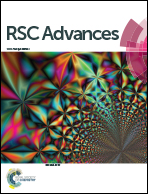Co2+ detection, cell imaging, and temperature sensing based on excitation-independent green-fluorescent N-doped carbon dots†
Abstract
Green-fluorescent N-doped carbon dots (N-CDs) have been successfully fabricated using hydrothermal treatment of tyrosine and urea. The N-CDs obtained showed excitation-independent emission, superior stability and strong photoluminescence with a quantum yield of ca. 9.8%. Based on these striking behaviors, the as-prepared N-CDs have been utilized in Co2+ detection and temperature sensing. Due to an inner filter effect, the N-CDs obtained were dramatically quenched by Co2+ with linear ranges of 0.1 μM–10 μM, 25 μM–275 μM and 300 μM–400 μM, and they had a detection limit of 0.15 μM. The use of the as-prepared N-CDs has been extended to visualize Co2+ fluctuations in living cells. Additionally, the N-CDs obtained have also been applied for use as a temperature sensor with a linear range of 25–80 °C.



 Please wait while we load your content...
Please wait while we load your content...